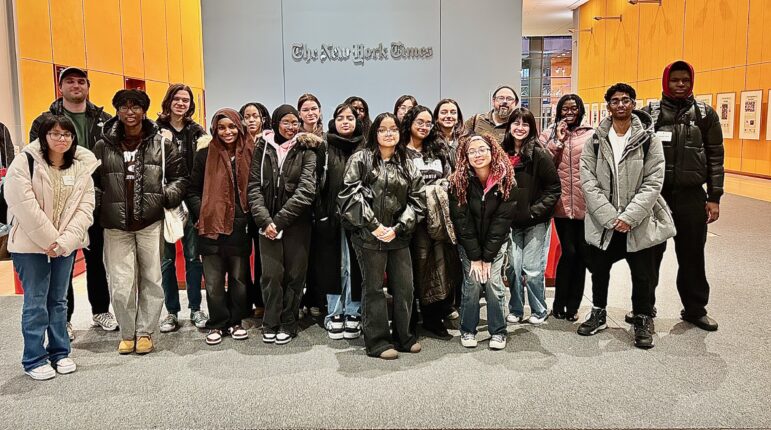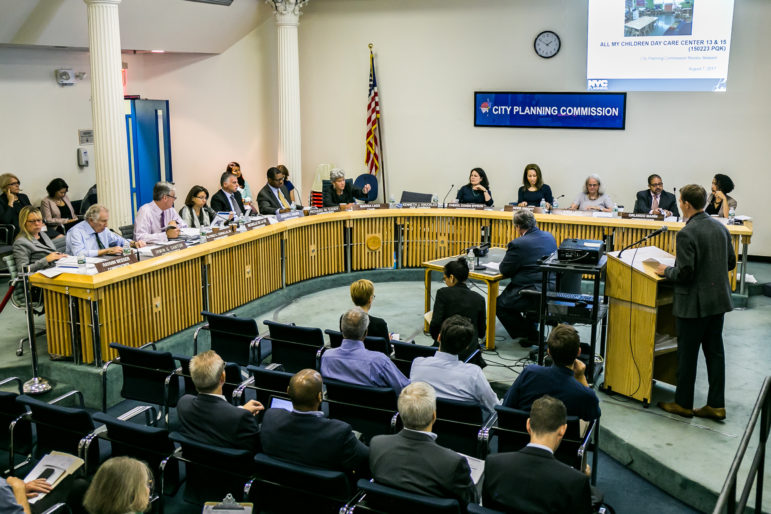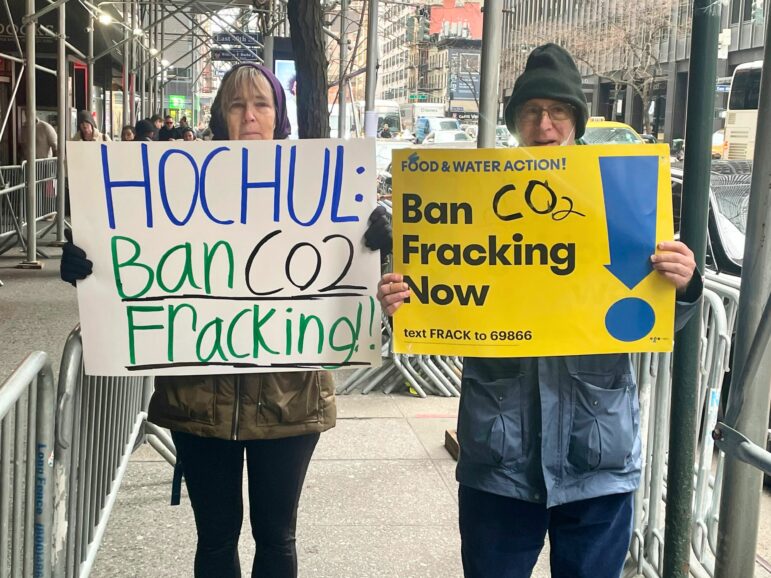
ICE
The overwhelming docket in immigration court is a challenge for U.S. Immigration and Customs Enforcement, which sees its job as preventing fraud.
This is the third chapter in a five-story series on the policy problems and human dramas that characterize immigration court in the New York City area. Be sure to check out the rest of the series.
* * *
At first, the painfully thin young man with a smile like a light bulb and a soft voice who I’ll call Sebastian, didn’t want to speak to me. We were standing outside an immigration courtroom at 26 Federal Plaza. But I pushed, disregarding his resistance. I asked him again through my translator to tell me his story.
“It wasn’t that bad,” he insisted with a shrug and a shy smile. The trip from Guatemala took a month—10 days in Mexico, then one week in the Texas desert. There, the group he was traveling with ran out of food and water, wandering for three days until they found a dirty spring. They filtered the water through their shirts, sucking down the moisture through the material. “We had no choice. We needed it,” he remembered.
They had started out as a modest group, which at one point swelled to 30, but by the time they entered Texas, there were only 12 left. Some hadn’t made it through the desert. They couldn’t keep up, or they fainted from the heat or lack of food. They “stayed,” he kept saying to my translator.
That was three years ago, when he was 17. I asked what brought him to the U.S. He answered simply: “Salir adelante“—opportunity, the chance to get ahead in life, to make something of himself—the American Dream, if you will, in colloquial Spanish. There is nothing in his tiny village, he said: no work, no future, nothing for a young man to do. Since coming here, he has been employed as a carpenter and a painter. He likes it here. He is happy.
“Everyone has a story,” he insisted again, his bravado reigniting with his smile. “For some, it’s an adventure. For some it’s sad.” He wouldn’t say how his own story should be labeled, but smiled again and looked away.
The biggest group of individuals currently passing through American immigration courts comes from Central America. According to information from the Department of Homeland Security, they made up 56 of the people whom DHS sought to deport in 2014, and 42 percent in 2015. They are fleeing horrible conditions in their home countries of Honduras, Guatemala, and El Salvador, where murder and gang violence have escalated in recent years. (By contrast, immigration from the relatively quiet Nicaragua is rarer.) In 2014, 21 percent of those whom DHS sought to deport came from Honduras, which was the second consecutive year Honduras held the title for murder capital of the world.
The trip is grueling. To get here from Central America, they must pass through the turf of gangs who specifically target migrants. They have often ridden on dangerous trains from which people fall and lose limbs and sometimes their lives. Migrants are kidnapped, held for ransom, tortured, murdered; they are extorted by gangs and officials alike. Some can’t keep up and are left behind to die while crossing the desert into Texas or Arizona. Those who keep going often pass dead bodies lying in the sand, or skeletons picked clean by wild animals. Between 60 percent and 80 percent of women who pass from Central America to the United States are raped in Mexico according to the most recent estimates. Mothers already in the U.S. who wish to bring their daughters here from these countries have been known to mail their daughters birth control before they undertake the journey—so they wont get pregnant when they are almost inevitably raped.
“We don’t know how many children have not survived the journeys,” says Jojo Annobil, attorney-in-charge of the Immigration Law Unit at the Legal Aid Society. “That’s an untold story.”
“When you look at the situation in Europe today and you see all those pictures of children drowning at sea—you can relate to the fact that this has been happening in our backyard for years, just that we don’t see them because a lot of these kids are left and probably preyed upon by wild animals.”
But those who make it will be faced with another ordeal. In 2013 alone, more than 400,000 people were deported from the United States, more than half of them non-criminal aliens, meaning they were not picked up because they’d been convicted of a crime. The Obama Administration has deported over 2 million people—more than any other president in the history of this country.
In the wake of the arrival of 70,000 unaccompanied minors in 2014, Obama promised to prioritize these cases. “This includes fulfilling our legal and moral obligation to make sure we appropriately care for unaccompanied children who are apprehended, while taking aggressive steps to surge resources to our Southwest border to deter both adults and children from this dangerous journey,” he wrote in a letter, leading these cases to be called the “surge.”
“This surge of resources will mean that cases are processed fairly and as quickly as possible, ensuring the protection of asylum seekers and refugees while enabling the prompt removal of individuals who do not qualify for asylum or other forms of relief from removal,” the president wrote. Some number of these surge cases—in particular, the women with children—are held in detention centers along the border.
The surge cases have gone to the top of what’s known as “the docket”—the list of cases handled by the country’s immigration courts, wreaking havoc on the already overburdened system. Immigrants who have been in proceedings for many years have had their cases pushed off, some to as far as off as 2020.
“It’s so hard to understand how badly the Obama Administration bumbles these framing issues,” says Peter Markowitz, director of Cardozo Law School’s Immigration Justice Clinic. “We have children—women and children—fleeing horrible violence, going through horrible danger to get to the United States. And to talk about them as some kind of dangerous surge, instead of the real refugee crisis that they are, and to lock them up in droves in detention centers … is really appalling.”
But the problems in immigration court do not stem from the surge; the surge has merely exacerbated the crisis in a system that is collapsing under its own weight. As of August 2015, there was a backlog of almost half a million pending immigration cases. The average wait time is 648 days and growing. A 2011 report found that immigrants received “inadequate” legal assistance 33 percent of the time and “grossly inadequate” assistance in 14 percent of the time.
And those are the lucky ones who have a lawyer; fully two-thirds don’t have any representation at all, despite the fact that the process is adversarial. In the vast majority of cases, there is a trained government attorney arguing for the immigrant’s deportation.
The future of immigrants seeking to stay in this country is determined by a court that is—by the admission of its own judges—chaotic, dysfunctional, and in a state of crisis, leading some to question whether the law is being applied justly.
A narrow door
Last year, in response to the unaccompanied children crisis, the U.S. created the Central American Minors program to allow children with a parent in the U.S. –children who would otherwise face violence in their home countries—to apply for refugee status while still in their home country. In theory, the program is supposed to be a way for kids to access the system without having to make the dangerous journey. But so far, the program hasn’t approved a single child.
A small number of immigrants with “valuable skills” are also allowed to stay in the U.S. each year, as are 70,000 refugees, though in 2015, only 2,300 refugee visas were allotted to Latin America and the Caribbean. And while that number is rising slightly, to 3,000 in 2016, it’s a drop in the bucket overall.
The U.S. signed the 1967 Protocol to the Convention on the Status of Refugees, which defines a refugee as a person who is afraid to return to their country because of a well-founded fear of persecution on account of a “protected ground” such as race, nationality, religion, political opinion, or what’s called a particular social group—like homosexuality, for instance. These categories were developed back in the 1950s, in the wake of the Second World War, a bias that still shadows them.
“The categories were decided by white men for white men,” says Jason Dzubow, an asylum lawyer in D.C. who writes the blog The Asylumist. In the intervening years, policies have evolved somewhat to help women, gays, and victims of domestic violence and female genital mutilation. But, as with everything to do with immigration, “that was more the result of lawyers pushing the definition of the law than it was as the result of a debate within the legislature and Congress coming up with a new definition,” Dzubow says.
Refugees must apply for refugee status from outside the U.S., but a person who has entered the U.S. who qualifies for refugee status by fearing persecution in their home country may apply for a different status, asylum, within a year of entering the country. And asylum cases get decided in immigration court.
Perhaps most glaringly for the majority of our current immigrants, United States immigration law doesn’t recognize fleeing gang violence as a viable cause for asylum. For a person who cites a fear of returning to their home country for a social ill that plagues everyone—like a gang terrorizing the neighborhood, or a civil war—asylum can be difficult to achieve.
There is an astonishing amount of variability in the outcomes of immigration petitions based on which judge an immigrant gets. A website curated at Syracuse University tracks these numbers, and found, for example, that from 2009-2014, Los Angeles Judge Rachel Ruane denied 94 percent of the 103 cases she presided over, whereas Judge Stephen Sholomson, also an L.A. immigration judge, denied just under 24 percent of the 272 cases he heard.
The immigration judge is the impartial fact-finder in an asylum case—their role is to determine if the immigrant, called “the petitioner,” is telling the truth, and faces a threat in their home country based on the categories outlined in immigration law. The emotional burden of this role is incredibly high. A 2007 survey found that immigration judges have a higher burnout rate than prison wardens. The judges, whose “enormous caseloads consist of one horrific story of human suffering after another, are at risk for stress and burnout, conditions which make adjudicating cases that much more challenging,” the survey found.
“We’re ruling on death penalty cases in a traffic court setting,” Judge Dana Leigh Marks, President of the National Association of Immigration Judges, told me (speaking on behalf of that organization and not the DOJ, she was careful to note). “If we’re wrong on asylum cases—and sometimes even if we’re right—the law may require me to send somebody back to a country where their life is at risk. And that’s pretty hard to handle.”
The challenges are not only emotional—they are practical. Immigration judges are overwhelmed and under-resourced. According to Judge Marks, last year, DHS hired 23 new judges; 22 retired. The judge spoke to City Limits when she was in New York for a panel discussion on immigration called “Crisis and Chaos: Delays in the Immigration Courts.”
The chaos and dysfunction of immigration courts in the U.S. affects not just the judges. It has a devastating impact on the immigrants, who are stuck in limbo while waiting for a court date. “They have no closure,” Cheryl David, a private-practice immigration lawyer, said at the panel discussion. “They can’t move forward with their lives. They don’t know what’s going on, if they are staying or going. ‘Should I buy a house? Should I get married? Should I have a child? Should I have five children? Will it help my case?’ You get calls like that,” She went on. “They can’t travel, they can’t work, they can’t move forward.” And their cases grow stale. “They don’t take the process seriously anymore,” she said. “Would you? If your case wasn’t for three or four years from now, why would you think it’s that important?”
Some immigrants pass those years of waiting in their communities, while some do so in immigration detention centers or in prisons, languishing without even a bond hearing to determine if they will be a threat to the community or a flight risk.
A challenge for ICE
But the overwhelming docket is a challenge for U.S. Immigration and Customs Enforcement, known as ICE, too.
“The docket is huge and it keeps growing,” said Wen-Ting Cheng, chief counsel for ICE in New York, in her office at Federal Plaza in November. “Partially, it’s a matter of supply and demand,” she explained. There are a lot of people who want to have an opportunity to stay in the United States, and they are entitled to their due process. But the staffing levels for ICE and for immigration judges are based on factors that don’t recognize the developing complexity of the law in recent years. When I asked if politics plays a role, Cheng smiled and said, “I can’t answer that.”
Cheng oversees the 85 attorneys representing the government in immigration court in New York. She has been with ICE for close to 20 years.
“I do it because I am the daughter of immigrants,” she said. “I am an immigrant myself, having immigrated to the United States when I was three years old. I’m a great believer in the fact that immigration makes this country great. It’s just we need to have enforcement of the immigration laws so the system can function the way that Congress intended and benefit those who the laws are set up to benefit and protect.”
Cheng sees a crucial part of her office’s role as protecting the system—and those who it was deigned to assist—from the biggest vulnerability in U.S. immigration court: fraud. She insists there is a lot of it. “For some of the same reasons that make the system great, it can also make it vulnerable,” Cheng said.
She explained that the laws are set up so that an individual’s testimony carries a lot of weight in court without requiring a lot of documentary evidence. As a practical matter, Cheng went on, if you’re a genuine refugee and you are fleeing, you might not have identifying documents with you that would prove or disprove your claim to belonging to a certain social group. So the courts have to rely on a person’s word, but that creates vulnerabilities. “Unfortunately when you have a system where you’re highly reliant on an individual’s testimony you do have that opportunity for fraud,” Cheng explained. “Some people will come in and not tell the truth, even under oath and in court.”
Others will embellish their claims, or flat out fabricate them, Cheng said; they lie about being in real marriages, or about the circumstances of the country they are fleeing. “And there are unscrupulous attorneys who also get involved with these fraudulent applications.”
At Federal Plaza and Varick Street, the two New York Immigration Courts, there are long lists of disbarred immigration attorneys. Some are prosecuted, like a recent high-profile case involving 30 defendants from lawyers to paralegals to interpreters, all accused of immigration fraud in the Chinese community.
Cheng, who was formerly an immigration lawyer in private practice, understands where the lawyers are coming from. “As a private attorney, you only think about your client,” she said. But as a representative of ICE, “our goals here trickle down from Washington. Our priorities can change and shift over time. You just feel there are factors that are sometimes bigger than any individual case.”
I asked Cheng if she ever feels that those policy factors come at the expense of justice for individuals.
“I can’t answer that,” she said again with a smile.
Asylum Hearings Decide Whose Danger
Makes Them Deserving
City Limits is grateful to the readers who donated to create this project along with the generous underwriting of Beacon.
* * *









2 thoughts on “Those Seeking Better Life, Agency Pledged to Detect Fraud Clash in Immigration Court”
Still, there is the untold and rarely heard stories of the merging victim class of women whom are in fraudulent marriages where the men are users trying to seeking a better life. I highlight a story related to this and hope that you will read on: http://www.wantedgreencard.wordpress.com
I say that the US change it’s laws to allow expedited removal of all illegal border crossers who arrived in the last 12 months. Currently ERs are only for border crossers who arrived in the last 14 days. This would relieve a lot of pressure on the immigration judges.
Also bringing a kid with you over the border should never be a get out of deportation free card.
We also need interior enforcement, especially for the people who overstay their non-immigrant visas. If you came to the US on vacation or as a student, you are not entitled to just stay.